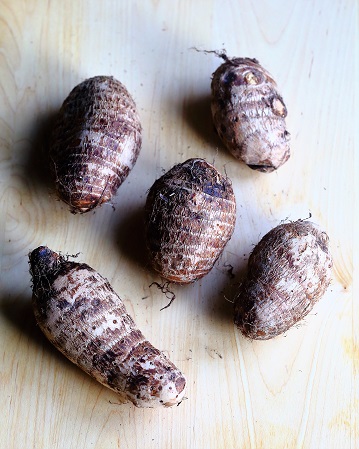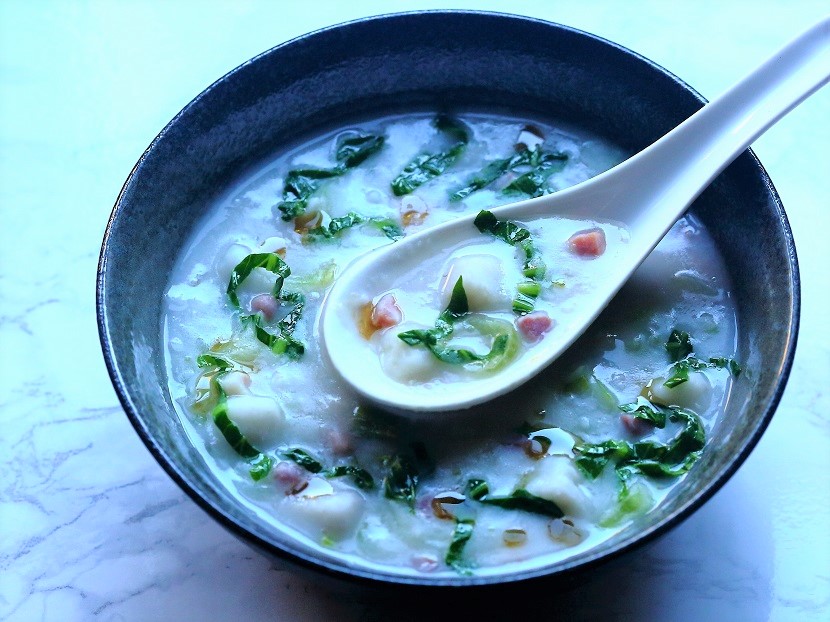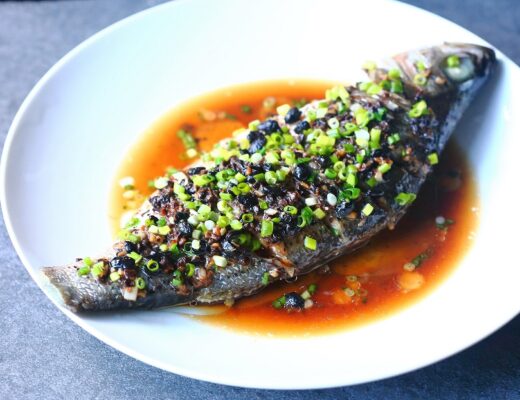Last Updated on December 12, 2020 by Simon Fan
Taro, a delectable root vegetable consumed in many parts of the world, is a favorite ingredient in Chinese cooking.
Like potatoes, the starchy corms of taro (yutou 芋头, yunai 芋艿) can be boiled, steamed, stir-fried, fried, and braised. They’re great for making desserts too.
There are mainly two taro varieties used in cooking, both available at Asian markets in the US. The corms of the larger variety have leathery skin and white flesh with purple specks throughout. They’re often sold already peeled and cut into rounds or cubes.

The corms of the smaller variety, sometimes called eddoe or eddo, have hairy skin with white flesh inside. I’m particularly fond of the smaller variety—when cooked, they taste like potatoes but have a slightly sweeter, nuttier flavor with a creamier and slippery texture.
In Shanghai and the surrounding regions, thick soups made with small taro corms are always crowd-pleasers, especially in the fall and winter. When taro cubes are simmered in stock until broken down, they release their starch to make the soup rich and creamy—very much like thick potato soups most people in the West are familiar with, but without the use of heavy cream, sour cream, milk, or cheese.
My recipe includes bok choy and ham to turn the soup into a one-dish meal. Give it a try and you’ll love your new “potato soup.” You can use the same method to cook larger taro corms as well. If you like, swap the ham for mushrooms to make the dish vegetarian.
Thick taro soup with bok choy and ham (青菜火腿芋艿羹)
Serves 2
Ingredients
11 oz (310 g) small taro corms
4 oz (115 g) Shanghai bok choy, preferably baby bok choy
2¼ cups (540 ml) unsalted or low-sodium chicken stock, pork stock, or vegetable stock
1 tablespoon vegetable oil
1½ oz (45 g) Chinese ham or another dry-cured ham (such as prosciutto, jamón, or country ham), cut into ⅙-inch (4 mm) dice, or substitute Chinese sausage or bacon
Salt and freshly ground white pepper
½ teaspoon sesame oil
Directions
- Wearing kitchen gloves (to avoid possible itchy skin), peel the taro corms and cut them into approximately ½-inch (1.3 cm) cubes.
- Cut the bok choy stalks crosswise into ½-inch (1.3 cm) pieces (half the stalks lengthwise first if they’re large), and cut the leaves crosswise into thin strips.
- Place the taro and stock in a pot. Bring to a boil over high heat, then lower the heat to maintain a steady simmer. Cover and cook, skimming off surface foam, until the taro is very soft, about 10 minutes. Turn off the heat, and use a slotted spoon to transfer the taro cubes to a plate. Use a potato masher or the back of a large spoon to mash three-quarters of the taro into a coarse paste, leaving the remaining quarter intact.
- Heat the oil in a wok or skillet over medium heat until shimmering. Add the ham and stir-fry for 1 minute. Transfer the ham (leaving the oil in the wok) to the stock in the pot and add the bok choy stalks. Bring to a boil and then lower the heat to simmer for 3 minutes. Return the taro (both mashed and unmashed) to the pot, stir to combine, and cook for 2 minutes for the flavors to blend. Turn off the heat.
- Heat the remaining oil in the wok over high heat until shimmering, then add the bok choy leaves and stir-fry until they’ve just wilted, about 30 seconds. Mix them into the soup, and season to taste with salt and pepper. Serve drizzled with the sesame oil.



